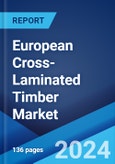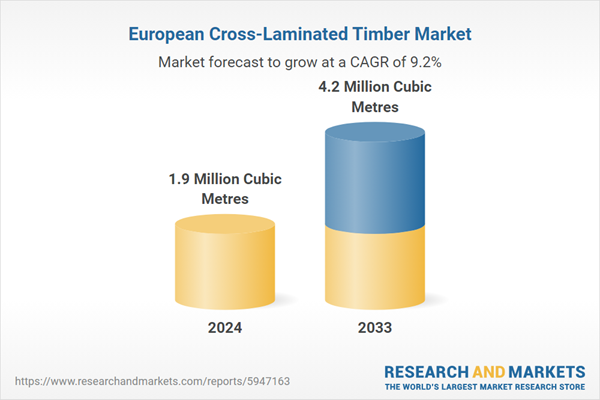Cross-laminated timber (CLT) is a wood panel product made from gluing together multiple layers of solid-sawn lumber. Each layer is oriented perpendicular to the adjacent layers, which enhances the material's strength and stability. The layers are bonded under pressure to form panels that can be used for a variety of structural applications, including walls, floors, and roofs. CLT offers benefits, such as reduced construction time, lower carbon footprint, and excellent thermal performance as compared to traditional building materials like concrete or steel. It has gained recognition for its versatility and is increasingly being adopted in residential, commercial, and institutional construction projects.
The increasing focus on sustainable construction practices represents one of the key factors driving the growth of the market across Europe. The European Union's environmental policies and guidelines actively encourage the use of renewable materials, and CLT fits well within this framework due to its lower carbon footprint as compared to traditional building materials like steel and concrete which is contributing to the growth of the market. The market is also driven by technological advancements, which are leading to the production of high-quality and versatile CLT products that are used in various types of construction projects, ranging from residential to commercial. The material's properties of strength, stability, and thermal insulation make it increasingly attractive for architects and engineers. Additionally, there is a rising awareness and acceptance of wood as a viable construction material among consumers and professionals alike which is fueling the market growth. Moreover, cost and time efficiency also play a significant role. CLT often allows for faster construction times, which is a crucial factor in its selection of projects with tight schedules or budget constraints, thus creating a positive outlook for the market across the region.
European Cross-Laminated Timber Market Trends/Drivers
Rise in environmental sustainability
The growing emphasis on sustainable construction practices within the European Union is one of the most significant drivers in the market. In line with this, various environmental policies and green building certifications are encouraging the use of eco-friendly materials, and CLT is gaining prominence as a renewable, sustainable option. It offers a lower carbon footprint as compared to traditional construction materials, such as steel and concrete. This focus on sustainability is a compelling factor for builders, architects, and government bodies to adopt CLT in their construction projects.Significant technological advancements
Significant technological advancements are playing a pivotal role in driving the growth of the European cross-laminated timber (CLT) market. Innovations in manufacturing processes, precision engineering, and digital design tools have enhanced the quality, efficiency, and scalability of CLT production. These advancements enable the creation of larger and more complex structures, expanding the architectural possibilities of CLT in construction. Additionally, cutting-edge technologies facilitate accurate modeling, prefabrication, and modular construction methods, reducing construction timelines and costs. This synergy between technology and CLT's sustainable attributes positions it as a modern and adaptable building material, aligning with Europe's emphasis on innovation, eco-friendliness, and efficient construction practices.Rise in cost-efficiency
CLT offers advantages, such as faster construction times, reduced labor costs, and efficient material usage. As sustainable construction practices gain traction, CLT's lightweight nature facilitates easier transportation and on-site assembly, which leads to overall cost savings. Additionally, its thermal insulation properties contribute to long-term energy savings and lower operational expenses for building owners. This emphasis on economic benefits aligns with the growing demand for environmentally conscious and budget-friendly construction solutions across Europe, positioning CLT as an attractive option for sustainable and cost-effective building projects.European Cross-Laminated Timber Industry Segmentation
This report provides an analysis of the key trends in each segment of the European cross-laminated timber market report, along with forecasts at the regional and country levels for 2025-2033. The report has categorized the market based on application, product type, element type, raw material type, bonding method, panel layers, adhesive type, press type, storey class, and application type.Breakup by Application
- Residential
- Educational Institutes
- Government/Public Buildings
- Commercial Spaces
The report has provided a detailed breakup and analysis of the market based on the application. This includes residential, educational institutes, government/public buildings, and commercial spaces. According to the report, residential represented the largest segment.
Breakup by Product Type
- Custom CLT
- Blank CLT
A detailed breakup and analysis of the market based on the product type has also been provided in the report. This includes custom CLT and blank CLT. According to the report, custom CLT accounted for the largest market share.
Breakup by Element Type
- Wall Panels
- Flooring Panels
- Roofing Slabs
- Others
A detailed breakup and analysis of the market based on element type has also been provided in the report. This includes wall panels, flooring panels, roofing slabs, and others. According to the report, wall panels accounted for the largest market share.
Breakup by Raw Material Type
- Spruce
- Pine
- Fir
- Others
A detailed breakup and analysis of the market based on the raw material type has also been provided in the report. This includes spruce, pine, fir, and others. According to the report, spruce accounted for the largest market share.
Breakup by Bonding Method
- Adhesive Bonded
- Mechanically Fastened
A detailed breakup and analysis of the market based on the bonding method has also been provided in the report. This includes adhesive bonded and mechanically fastened. According to the report, adhesive bonded accounted for the largest market share.
Breakup by Panel Layers
- 3-Ply
- 5-Ply
- 7-Ply
- Others
Breakup by Adhesive Type
- PUR (Polyurethane)
- PRF (Phenol Resorcinol Formaldehyde)
- MUF (Melamine-Urea-Formaldehyde)
- Others
A detailed breakup and analysis of the market based on the adhesive type has also been provided in the report. This includes PUR (Polyurethane), PRF (Phenol Resorcinol Formaldehyde), MUF (Melamine-Urea-Formaldehyde), and others. According to the report, PUR (Polyurethane) accounted for the largest market share.
Breakup by Press Type
- Hydraulic Press
- Vacuum Press
- Pneumatic Press
- Others
A detailed breakup and analysis of the market based on the press type has also been provided in the report. This includes hydraulic press, vacuum press, pneumatic press, and others. According to the report, hydraulic press accounted for the largest market share.
Breakup by Storey Class
- Low-Rise Buildings (1-4 Storeys)
- Mid-Rise Buildings (5-10 Storeys)
- High-Rise Buildings (More than 10 Storeys)
Breakup by Application Type
- Structural Applications
- Non-Structural Applications
A detailed breakup and analysis of the market based on the application type has also been provided in the report. This includes structural applications and non-structural applications. According to the report, structural applications accounted for the largest market share.
Breakup by Country
- Austria
- Germany
- Italy
- Switzerland
- Czech Republic
- Spain
- Norway
- Sweden
- United Kingdom
- Others
The report has also provided a comprehensive analysis of all the major regional markets, which include Austria, Germany, Italy, Switzerland, Czech Republic, Spain, Norway, Sweden, United Kingdom, and others. According to the report, Austria accounted for the largest market share.
The report has provided a comprehensive analysis of the competitive landscape in the market. Detailed profiles of all major companies have also been provided. Some of the key players in the market include:
- Stora Enso Oyj
- KLH Massivholz GmbH
- Binderholz GmbH
- Mayr Melnhof Karton AG
- Hasslacher Holding GmbH
Key Questions Answered in This Report
1. What was the size of the European cross-laminated timber market in 2024?2. What is the expected growth rate of the European cross-laminated timber market during 2025-2033?
3. What are the key factors driving the European cross-laminated timber market?
4. What has been the impact of COVID-19 on the European cross-laminated timber market?
5. What is the breakup of the European cross-laminated timber market based on the application?
6. What is the breakup of the European cross-laminated timber market based on the product type?
7. What is the breakup of the European cross-laminated timber market based on the element type?
8. What is the breakup of the European cross-laminated timber market based on the raw material type?
9. What is the breakup of the European cross-laminated timber market based on the bonding method?
10. What is the breakup of the European cross-laminated timber market based on the panel layers?
11. What is the breakup of the European cross-laminated timber market based on the adhesive type?
12. What is the breakup of the European cross-laminated timber market based on the press type?
13. What is the breakup of the European cross-laminated timber market based on the storey class?
14. What is the breakup of the European cross-laminated timber market based on the application type?
15. What are the key regions in the European cross-laminated timber market?
16. Who are the key players/companies in the European cross-laminated timber market?
Table of Contents
Companies Mentioned
- Stora Enso Oyj
- KLH Massivholz GmbH
- Binderholz GmbH
- Mayr Melnhof Karton AG
- Hasslacher Holding GmbH
Table Information
| Report Attribute | Details |
|---|---|
| No. of Pages | 140 |
| Published | February 2025 |
| Forecast Period | 2024 - 2033 |
| Estimated Market Value in 2024 | 1.9 Million Cubic Metres |
| Forecasted Market Value by 2033 | 4.2 Million Cubic Metres |
| Compound Annual Growth Rate | 9.2% |
| Regions Covered | Europe |
| No. of Companies Mentioned | 5 |









